The page/section is undergoing one because conflicting number of dwarf planets. To discuss your opinion about the rewrite, see this talk page.
Do not remove this tag until the discussion has been resolved.
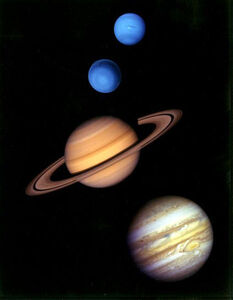
An image of the 4 outer planets; Jupiter, Saturn, Uranus, and Neptune.
The Outer Solar System is the area beyond Mars in the solar system. These objects are usually very cold, due to them being past the so called "frost line", approximately 5 AU from the sun.
There are 4 major planets (Jupiter, Saturn, Uranus, and Neptune) and 4 dwarf planets[Conflicted?] in the outer solar system (Pluto, Haumea, Makemake, and Eris). This part of the solar system is the largest, extending from Jupiter to the Oort Cloud (5 astronomical units to over 1.5 light years).
Gas and Ice Giants[]
There are 2 gas giants those being Jupiter and Saturn, and 2 ice giants those being Uranus and Neptune
Jupiter[]
Jupiter is the second largest object in the solar system, just behind the sun, and is 142,984 kilometers in diameter. It has thin rings that were discovered when the Voyagers flew by in 1979. It has 95 moons as of November 2023.[1]
Moons[]
There are 95 moons of Jupiter in total. The 4 largest moons of Jupiter are called the Galilean moons, named after Galileo Galilei, who discovered them in 1610. They consist of Ganymede, Callisto, Io, and Europa. They were the first moons discovered after the Earth's moon.
Ganymede[]

Galileo Galilei, the discoverer of the Galilean moons.
Ganymede is the largest of the 4 and is brown in color. It is the largest moon in the solar system, and is larger than Mercury. It was visited close up by the Galileo orbiter, and then the Juno orbiter in 2021.
Callisto[]
Callisto is the second largest and is covered in craters. It is around the same size as Mercury, only being a few kilometers short.
Io[]
Io is the second smallest of the Galilean moons, and is a yellowish in color. It is the most volcanically active object in the solar system, with major eruptions happening frequently.
Europa[]
Europa is the smallest of the four Galilean moons, and is a very icy body. It was visited by Juno in 2022. It might have an underwater ocean[2]
Saturn[]
Saturn is the third largest object in the solar system and is just over 120,000 kilometers in diameter. It is known for its very large rings that were discovered by Galileo in 1609. These rings were originally considered as smaller planets, ears or handles. It is a light brown in color, and it has 146 moons as of November 2023.
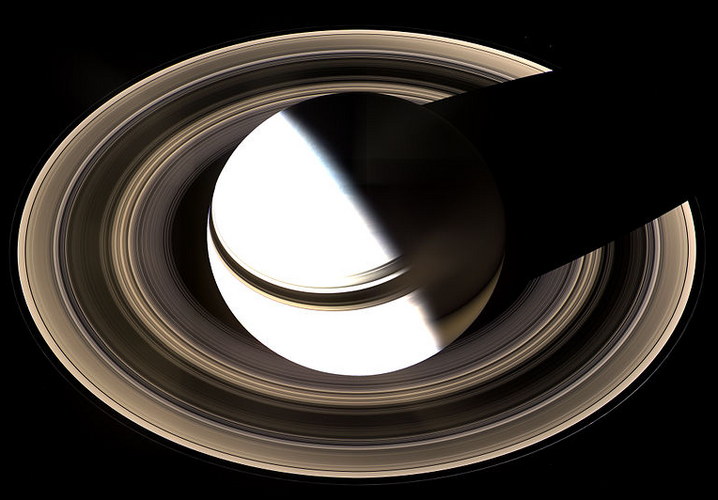
The rings of Saturn from above.
Rings[]
The rings of Saturn consist of rock and ice. They are theorized to have formed from the remains of a moon that was torn apart by tidal forces.
Moons[]
Saturn has 146 moons as of November 2023. Its largest moon, Titan, has a very thick atmosphere and bodies of liquid and Iapetus has a two-toned surface.
Titan[]
Titan is the largest moon of Saturn, and the second largest in the solar system, being 5,150 kilometers in diameter.
It has a very thick and hazy atmosphere that makes it yellowish-orange from above. Not much was known about it until Cassini-Huygens observed the moon, revealing large methane oceans.
Enceladus[]
Enceladus is white in color, and is only 504 kilometers in diameter. It "spits" water out from beneath the surface. It could have a possible underwater ocean, and even has chances for life.
Mimas[]
Mimas is a moon with a massive crater, called the Herschel Crater, which takes up 1/3 of its diameter. It is grey in color.
Uranus[]
Uranus is the fourth largest object in our solar system, was discovered in 1781 by William Herschel, and is cyan in color. It has 28 moons, with the largest 6 being Titania, Oberon, Umbriel, Ariel, Miranda, and Puck. It has white, dark rings, and is the 7th planet from the sun. It is 51,000 kilometers in diameter.
Neptune[]

Artist’s impression of what the surface of Triton might look like from someone standing on it.
Neptune is the fifth largest object in our solar system, was discovered in 1846 by Verrier. Neptune is dark blue in color. It has the most violent storms in the solar system, having winds over 1,000 mph. It had a large storm, called the great dark spot that disappeared in the 90s. It has 16 moons, with its largest Triton having chances of cloud cover. It has thin rings made of organic matter. It is 49,500 kilometers in diameter.
Triton[]
Triton is the largest moon of Neptune, being 2,706 kilometers in diameter. Triton is a collage of shades of green, white and others. It has cryovolcanoes on its surface.
Kuiper Belt[]
The Kuiper Belt is a region of icy bodies, including Pluto, beyond the orbit of Neptune. The first object in this region discovered was Albion, in August of 1992.
Dwarf Planets[]
There are three dwarf planets[Conflicted?] in the Kuiper Belt, them being Pluto, Haumea, and Makemake.
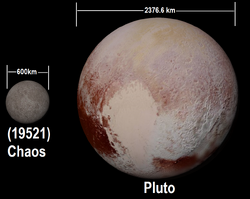
Size comparison of Pluto to another, smaller object, Chaos.
Pluto[]
Pluto is a dwarf planet, and former ninth planet, being discovered in 1930 by Clyde Tombaugh. It has brown and tan on its surface, and has 5 moons, being in almost a binary system with Charon. Charon is the largest moon of Pluto, and they both orbit around each other. Pluto might have a subsurface ocean, and the names of the four other moons are Hydra, Nix, Kerberos, and Styx. It is 2,376 kilometers wide.
Haumea[]
Haumea was discovered in 2004, and has a disputed discovery (click here for more on that). What makes it strange is that its shaped like an oval, due to its rotation speed of only 4 hours. It has 2 moons, being Hi’iaka and Namaka, and has a red splotch on its surface that may be rich in materials.
Makemake[]
Makemake is a red colored dwarf planet, and is the second brightest KBO, behind Pluto. Rumor has it that if Clyde Tombaugh looked some more, he might have found Makemake. It has one moon, not having an official name yet.
Dwarf Planet Candidates[]
Some KBOs and TNOs are large enough or qualify for dwarf planet status, and they are called Dwarf Planet Candidates (DPCs for short). As of 2023, some of the most prominent dwarf planet candidates are Quaoar, Orcus, Salacia, 2002 MS4, Varuna, and Ixion.
Quaoar[]
Quaoar is the second largest known DPC. It is orange in color, and has one moon, Weywot. Quaoar has a pair of rings that are outside of it’s Roche limit, baffling scientists. It might clump into a moon in a few decades.
Orcus[]
Orcus is a DPC in the Kuiper belt. It is grey in color, and has one moon that is over 1/3 of its diameter, Vanth.
Scattered Disc[]
The Scattered Disc is an area beyond the Kuiper Belt that consists of many TNOs that have larger and longer orbits then KBOs.
Dwarf Planets[]
Only one dwarf planet[Conflicted?] currently resides in the scattered disc, being Eris.
Eris[]
Eris is the only dwarf planet in the scattered disc, being 2,326 kilometers in diameter. It is one of the brightest objects in the solar system, and has 1 moon, named Dysnomia. It was discovered in 2003, and is one of the reasons for Pluto’s demotion.
Dwarf Planet Candidates[]
There are two major DPCs in the scattered disc as of 2023.
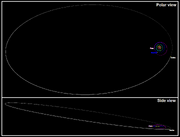
The orbit of Sedna, with a aphelion of 936 AU.
Sedna[]
Sedna is a dwarf planet candidate in the scattered disc. What’s different about it from other DPCs is that is has an orbital period of 11,000 years, way more than Eris’ 500 years. Sedna has an aphelion of 937 AU[3], and is red in color. It is 995 kilometers in diameter.
Gonggong[]
Gonggong is a red DPC in the scattered disc. It has one moon, Xiangliu.
Oort Cloud[]
The Oort Cloud is a very mysterious place in the outer solar system. It is 3 light years in diameter, and is only hypothetical. It possibly contains trillions of tiny icy objects and comets. This is where long-period comets are thought to come from. It will get disrupted when the star Gliese 710 enters our solar system in around 1.3 million years.
Hypothetical Planets[]
There are a few hypothetical planets that are thought to reside here.
Planet 9[]
Planet 9 is a hypothetical planets thought to reside in the inner Oort Cloud. It is an ice giant like Uranus and Neptune, but is way farther away. It is explained as the reason for the messy orbits of comets and some TNOs. It is supposed to be around 5-10 Earth masses,[4]
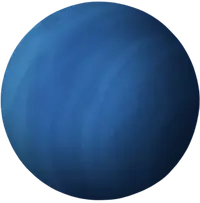
Artist’s impression of the Fifth Giant.
Planet 10[]
Planet 10 is a hypothetical planet in the inner Oort Cloud that is thought to manipulate orbits of TNOs along with Planet 9. It is presumed to be a rocky object, like Earth.[Citation needed]
Fifth Giant[]
The Fifth Giant is an ice giant like Uranus, and Neptune that is either in the outer Oort Cloud or is ejected from the system. It was claimed to orbit between Saturn and Uranus in the early solar system before getting ejected by Saturn and Uranus.[Citation needed]
Beyond the Solar System[]
The content of this page/section is out of context, meaning it has no meaning to the average user, has no definition and/or explaination, is out of place or does not pertain to the page/section's subject.
Please fix this by editing it
Beyond the Oort Cloud, you would enter interstellar space, as the sun’s reach extends up to the Oort Cloud. At over 4 light years, you would run into Proxima and Alpha Centauri, the closest stars to the sun. After that, the sun would just look like another star in the sky.
Bibliography/Refrences[]
- ↑ https://sites.google.com/carnegiescience.edu/sheppard/moons/jupitermoons
- ↑ https://link.springer.com/book/10.1007/b138547
- ↑ https://ssd.jpl.nasa.gov/horizons_batch.cgi?batch=1&COMMAND=%27Sedna%27&TABLE_TYPE=%27ELEMENTS%27&START_TIME=%271900-01-01%27&STOP_TIME=%272500-01-01%27&STEP_SIZE=%27100%20years%27&CENTER=%27@0%27&OUT_UNITS=%27AU-D%27
- ↑ https://iopscience.iop.org/article/10.3847/1538-3881/ac32dd